WIRELESS HEART RATE MONITORING TECHNOLOGY
A UNIQUE PHOTO PLETHMOGRAPHY HEART RATE SENSOR
This work was funded in part by an NIH PHASE 1 Grant � A Phase II Grant is pending.
PGS has developed an innovative low cost infant monitoring technology that is completely wireless and requires no intimate patient contact. The PGS monitor combines a state-of-the-art FDA pre-market approved wireless noninvasive inductive respiration sensor with new photo sensor technology for acquiring heart rate, eliminating ALL wires and electrodes. As medical advances improve, the survival rates of pre-term and low-birth weight infants in the U.S. continue to rise along with the need for cost effective monitoring.
A phase I feasibility study conducted at Children�s National Medical Center, Washington D.C. demonstrated that a viable and stable physiological pulse pressure waveform could reliably be acquired at the umbilicus area of the abdomen on low birth-weight infants in the hospital�s NICU. The abdominal area was previously deemed inappropriate for monitoring. We further combined the cardiac sensor with the existing PGS wireless inductive respiration sensor. The clinical data collected in the phase I study demonstrated that the PGS motion artifact rejection performance was superior to the reference pulse oximeter monitor.
CLINICAL SNAPSHOTS (NIH PHASE I)
The figures below represent the overall performance of the PGS Wireless Respiration and Cardiac sensor when compared to a widely used wired hospital reference monitor.
The NIH Phase I clinicals were very encouraging in demonstrating the veracity of obtaining a usable cardiac pulse pressure waveform from the umbilical region of the infants studied. Previous to this investigation it was generally accepted that the lack of arterial flow would hamper the use of a photo sensor in this area of the body. The key features to note are the stability of the base line (middle trace) of the PGS sensor when compared to the reference monitor, and the relative immunity to normal respiration artifacts when compared to the loss of signal on the reference monitor. The most important advantage to this new location is in the realization that the abdominal wall of the umbilical area moves as one on a relatively large plane. This affords a far more stable area for the sensor than on an arm or leg producing consistent signals even when the infant�s arms or legs are in motion. The infants ranged in weight from 2 to 4 pounds.
|
RESPIRATION ARTIFACT
REJECTION EXAMPLE:
SINGLE EXCURSION
|
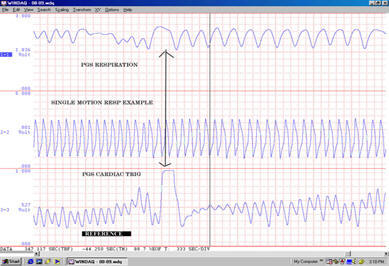 |
|
RESPIRATION MOVEMENT
ARTIFACT EXAMPLE:
MULTIPLE EXCURSION
|
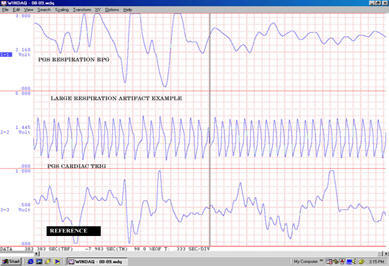 |

BLOOD PRESSURE
PGS OCCLUSIVE DETERMINATION SYSTEMS:
FAST & ACCURATE - PGS has developed a proprietary software driven intermittent (pump up) blood pressure monitoring system that delivers reliable Systolic / Mean / Diastolic / Heart Rate data within 10 seconds upon start of measurements and under 6 seconds after the first occlusive determination. The system meets or exceeds the AAMI standards for Blood pressure monitors.
LINEAR BLEED - The unit incorporates a Linear Bleed which unlike �stepped� systems provides very accurate determination as ALL waveforms are associated with real time pressures rather than in 5 to 7 mmHg steps. There is no skewing of the occlusion envelope. LOW POWER � Using a state of the art pump, and extremely low power valve, the system reflects an optimal design for long battery life in ambulatory products.
WIRELESS CAPABILITY - This system is compatible with the PGS RFID wireless system and can provide remote patient data acquisition for the hospital and in home environments.
PGS CONTINUOUS BLOOD PRESSURE SYSTEM
CVC BLOOD PRESSURE MONITOR
An INVESTIGATIONAL CONTINUOUS VOLUME CORRECTED NONINVASIVE BLOOD PRESSURE MONITORING SYSTEM
The PGS Medical Research & Electronic Design CVC technology represents the first noninvasive continuous blood pressure (NICBP) monitor with the potential of real time arterial pressure measurement in the presence of blood volume changes and motion artifact. The improvement and reliability for noninvasive blood pressure measurement afforded in using the CVC technology is striking.. The CVC technology has the convenience and ease of use of an inflatable occlusive cuff type monitoring system with the added potential of being able to monitor a patient�s arterial pressure continuously without the limitations associated with intermittent cuff measurements. PGS has a US patent for this technology.
PGS Medical Research with the CVC NICBP has successfully solved two of the most serious limitations of the current noninvasive continuous monitors. The first limitation of other systems is their inability to respond correctly in the continuous modality to blood volume changes without re-calibration. The second limitation is the inability of all current noninvasive monitors to withstand the type of body motion artifacts (noise) typically occurring in the patients in which blood pressure is being measured -i.e.: shivering, muscle tremor etc.). These motions obliterate the incoming signals used to compute blood pressure and render the continuous function useless- usually just when the clinician needs the information the most.
The above limitations have severely restricted the use of the continuous noninvasive blood pressure monitors � until now.
CVC FEATURES -
1. The PGS CVC pressure monitor does NOT rely on the pulse amplitude (ballistic) for the computation of the mean arterial pressure. There is no usable portion of the elasticity curve in the patient population that will correlate with central or arterial pressure with blood volume or vasoautonomous physiological changes. Everyone's peripheral resistance changes as a function of the impulses received from the medullary vasomotor center of the brain, and does so continually but not predictably. 5 This is only one of the many factors contributing to "reverse trends" seen in monitors utilizing amplitude ballistics for calculation.
2. ARTIFACT REJECTION - The PGS CVC technology does not suffer from the high degree of artifact present in other systems. The PGS NICBP requires only an electrical gain of 3 ( instead of the 1500 utilized by most systems) to accomplish it's measurement and therefore is immune from most of the typical motion artifact presented in other monitors.
SCREEN CAPTURE OF CVC � 20mm monitoring
The Screen Capture below is described as follows: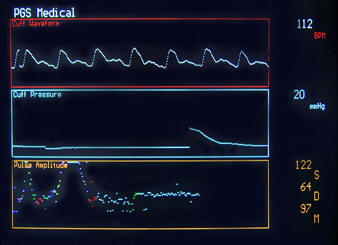
TOP TRACE: represents the real time pulse pressure waveform at approximately 20-mm. This signal clearly shows the dichrotic notch as well as other features of the BP waveform.
MIDDLE TRACE: is a linear display of actual cuff pressure but at a reduced (compressed) scroll rate. The hump 2/3 to the right represents a pressure correction change of the cuff pressure to bring it into the 20 mm range.
BOTTOM TRACE: represents pulse amplitude. It is scrolled at a still slower rate. This trace starts at the beginning of an occlusive determination. Approximately 1/3 from the left side of the trace you can see the occlusion is complete and pulse amplitude is diminished to nominal 20 mm heights.
NIH PHASE 1 Clinical Investigation Status:
-
PGS is in the process of clinical evaluation of the CVC non invasive blood pressure system.
-
In addition an NIH grant submission has been submitted for further funding of this technology and to establish the veracity of the technique in preparation for FDA 510K submission.
General Information about Blood Pressure Measurement:
PUMP UP OCCLUSIVE DEVICES - description
"Pump up" type devices that periodically inflate a cuff (occlusive determination) and display the patient�s pressure. These "pump up� type procedures are effective on less critically ill patients but are inadequate for OR procedures that require constant real time monitoring of a patient's pressure. Attempts to occlude at more frequent intervals (i.e.: Stat Mode) with the intermittent "pump up" occlusive machines can lead to nerve damage of the limb and other patient complications. Most physicians prefer to see the actual pulse pressure waveform that is generated each time the heart pumps. This information is unavailable on automated or manual occlusive units. These devices do not monitor continuously.
Several well known companies have attempted to introduce noninvasive continuous monitors that rely on the pulsatile information contained in the pulse pressure waveform. These systems rely on measuring the amplitude and area under the curve (integration), or various combinations of techniques that try to extract information based on the arterial compliance or elasticity of the arterial wall as a predictive function of blood pressure. A few have met with limited success in the ICU on patients that are sedated or immobile. 3 All have the following restrictive limitations of use:
1. They are extremely susceptible to motion artifact despite claims to the contrary. These monitors will automatically go into the occlusive determination procedure when in the presence of motion artifact for any length of time, or stop monitoring altogether.4
2. Present noninvasive continuous pressure monitors are unable to deal with normal physiological blood volume changes. This prevents their use during critical operations, and precludes use in the dialysis units where large infusions of blood are occurring on all patients.
DEFINITIONS, TECHNOLOGY, & PHYSIOLOGY
THE NON INVASIVE MEASUREMENT OF BLOOD PRESSURE IN A REAL TIME CONTINUOUS MODALITY -
OVERVIEW AND TECHNICAL DISCUSSION
Central Blood Pressure has traditionally been measured by the insertion of a hollow needle (catheter) into a functioning artery. The needle tip is kept clear of clotting blood by a small amount of heparin (anticoagulant) or other similar compound that inhibits clotting of the blood. A tube is connected from the needle and any entrapped air is vented by way of a valve to atmosphere. Another port on the valve connects with a traditional pressure sensor device. This sensor outputs a direct current voltage that can be calibrated to pressure
PULSATILE AMPLITUDE METHOD
The company states that in its view the use of pulsatile amplitude measurement as a basis for on line continuous computation of the vital sign of blood pressure is dangerous, produces reversed trends, and can lead to the administration of medication that is the opposite of that required for critical and nominal care in controlling blood pressure.
THE REASON -
The following are the main disadvantages and dangers associated with the use of pulsatile measurement as a basis for the computation of continuous blood pressure based on an initial occlusive determination.
1. The stress / strain curve for the arterial wall is a complex function. If the artery were looked at alone in space, it would still be complex. The walls of the artery are comprised of several layers some of which are smooth muscle susceptible to the sympathetic nervous system responses. These walls react to various stimuli from the body. The vasoconstrictor fibers surrounding the major arterial and venous blood vessels can greatly change the resistance, and compliance (elasticity) of the measured vessel. Obviously, if the elasticity of the pulsating (measured) artery were to change the amplitude of the pulsations would change also. Unfortunately, if we take an example of what happens when this occurs, the limitations of the pulsatile amplitude method of continuous pressure measurement are readily seen.7 It is known that when peripheral resistance increases, that the impulses from the medullary vasomotor center increase in rate to the vasoconstrictor fibers mentioned above. This is known to raise arterial pressure and is in fact the primary means that the body utilizes to regulate pressure.8 The importance of peripheral circulatory resistance in the body's regulation of blood pressure can be attributed to the fact that over 80% of the blood volume is contained in the venous and capillary systems! 9
As the fibers constrict about their vessels, the compliance, elasticity, and pulsatile ability decrease past a certain pressure point (different for all individuals but relatively low in patients with hypertension) and compromised, i.e. (calcified, hard, old, or clogged) vessels.) This effect will cause a lowering of pulsatility for a rise in pressure. This is exactly the opposite of what is supposed to happen according to the pulsatile measurement technique. That is based on the premise - that if the amplitude is increasing, then the pressure is increasing. The converse is also true, that as peripheral resistance goes lower (more compliant) , the pulsatility will increase. This is erroneously interpreted by the pulsatile method as an increase in pressure where in actuality the pressure is going down.10
2. Peripheral changes in vessel resistance produce blood volume changes in the arm or leg. Any change in volume will cause a loss of calibration to the original occlusive reference. If for example more blood enters a fixed volume i.e., the upper arm, the skin acts like a balloon being stretched. As more blood enters the arm, the force of this interarm pressure becomes greater, acting as a constricting force on any pulsations of the vessels in the arm aimed back at the center of the vessel. Thus, as interstitial fluid, or blood increase in the appendage, the ability of the vessels to pulsate diminishes.11,12 This is again unfortunately the opposite of the desired result, as pressure in the limb is obviously increasing. The Colin medical device is less susceptible to this as the radial artery in the wrist is surrounded mostly by bone, and is very near the surface.13
3. The non linear relationship of the arterial stress/strain curve can, as the limited working range of the pulsatile method moves up or down on this curve, produce trends opposite that of what is actually taking place. These are caused whenever cardiac output (volume), or peripheral resistance changes occur. These changes occur frequently under anesthesia, intubation, and operating procedures.14
4. The indigenous signal to noise ratio is very low for the pulsatile measurements. The problem is that the power spectrum of the typical arterial pulse as acquired by the noninvasive pressure transducers is the same as the muscle and motion artifacts in many cases. Therefore, they are inseparable in either the time or frequency domains. No amount of software or signal processing can restore the data in these often occurring situations. The data is therefore discontinuous in many instances i.e., during an operation or tremor when it is most needed.
Note: The above discussion is excerpted from another longer document. However, the footnotes below apply.
3. De Jong MD, Tepaske MD, Ros PhD., de Lange MD, Phd, "Noninvasive Continuous Blood Pressure Measurements With the Cortronic APM 770: An Unfortunate Application of Computing Power," VU Academisch Ziekenhuis, Amsterdam, The Netherlands.
4. Maier WR , Noninvasive Blood Pressure Monitoring : Monitoring in Anaesthesia and Critical Care Medicine, New York, Churchill Livingstone, 1985, pp. 35-40.
5. Chaffee and Lytle, Basic Physiology and Anatomy, Philadelphia, J.B.. Lippincott Company, 1980, pp. 376-378.
7. Kalath, Satish, etal., "Non-Invasive Assessment of Aortic Mechanical Properties, New Jersey, Annals of Biomedical Engineering , Vol. 14, pp 513-524, 198
8. Fulton, John F., Physiology Of The Nervous System, New York , Oxford University Press, 1943,pp.429-435.
9. Rushmer, Robert F, MD., Cardiovascular Dynamics, Philadelphia & London, Saunders Company , 1968, pp. 8-12.
10. Vaessen, HHB, "Another Manner of Continuous Non-invasive Blood Pressure Measurement - an investigation", University Hospital Utracht, Institute of Anesthesiology ( 35 patient study).
11. Geddes and Baker, Principles of Applied Biomedical Instrumentation, New York, John Wiley and Sons, 1975, pp. 362-365.
12. Cromwell, Weibell, And Pfieffer, Biomedical Instrumentation and Measurements, New Jersey, Prentice Hall, 1980, pp. 163-16.
13. Bassenge, Eberhard, M.D., Munzel, Thomas, M.D., "Consideration of Conduit and Resistance Vessels in Regulation of Blood Flow", The American Journal of Cardiology, Vol. 62, No. 8 , 1988, pp. 2E-7E.
14. Perret, Waeber, Tardy, Meister, Burnier, and Brunner, "Compliance - Pressure Curves of the Radial Artery In Normal Subjects Under Prolonged Administration Of Atenolol, Lisinopril, Nitrendipine And Placebo," Proceedings of the 4th European Meeting on Hypertension, Ricerca Scientif., Perman. 76,676, 1989.

EKG / HEART RATE
EKG MODULES FOR CLINICAL RESEARCH
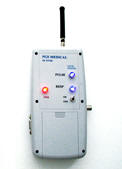  PGS can design and supply custom EKG modules tailored to the specific needs of the researcher�s clinical study. The modules can be either wired or WIRELESS and feature the following specifications. In addition PGS can provide software enabling display and control of EKG waveforms through the addition of an embedded PIC microprocessor. PGS can design and supply custom EKG modules tailored to the specific needs of the researcher�s clinical study. The modules can be either wired or WIRELESS and feature the following specifications. In addition PGS can provide software enabling display and control of EKG waveforms through the addition of an embedded PIC microprocessor.
EKG CUSTOMIZING
The modules can be configured to maximize one or more desirable features. For example, it may be necessary to acquire the transducer signal while the subject is moving about or exercising. PGS can then design the EKG module to maximize motion artifact rejection.
50/60 Hz. NOTCH FILTERING
Another Example is acquiring the EKG signal in the presence of severe noise such as 50 or 60-cycle mains interference. Below is an example of a customized PGS module and this type of noise. The top trace is the EKG processed out of that noise. For reference, the QRS signal input is a .5 mV. QRS from a Dynatech Nevada simulator. The noise was present with a dc offset of approximately 100 mV.. Channel 2 (filtered QRS) is displayed on top of the original signal for clarity. Channel one represents both the .5 mV. QRS and noise.
PGS 60 Hz. Notch Filtering of .5 mV. QRS EXAMPLE
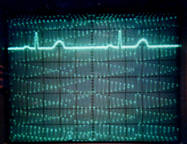 |
QRS : .5 mV.
NOISE: 60 Hz , 800 mV.
|
|